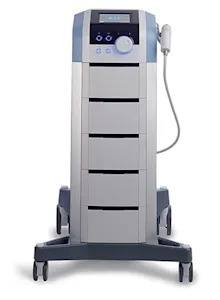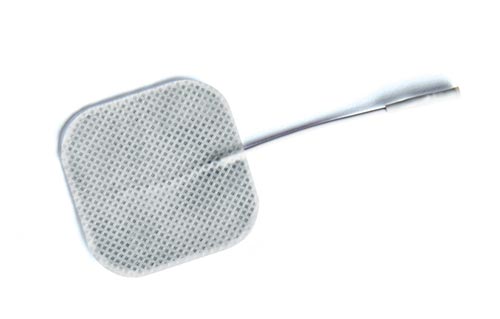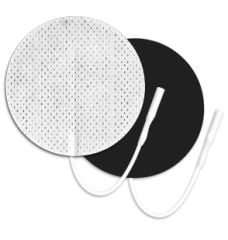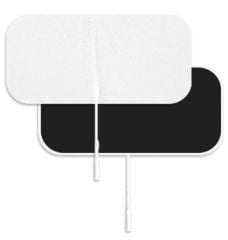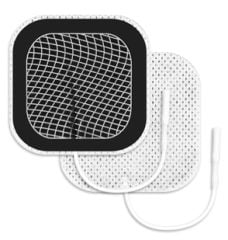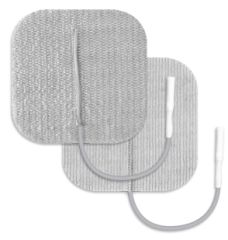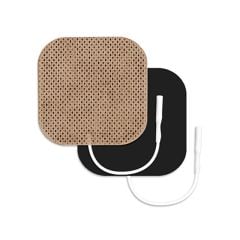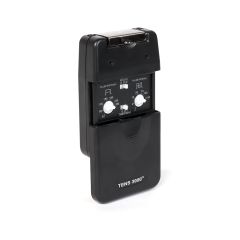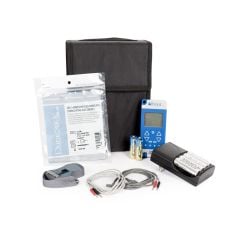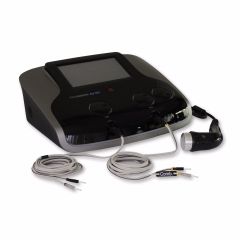Axelgaard
Electrode Education
We are pleased to sponsor the Electrode Placement and Functional Movement series presented by Dr. Lucinda Baker, Associate Professor at USC Division of Biokinesiology and Physical Therapy. These videos provide comprehensive information on the preparation and use of electrodes for effective neurostimulation treatment. All electrodes used in the video presentation are PALS¬ģ¬†neurostimulation electrodes. We trust these videos will assist your efforts in providing the most effective treatment to your patients.
Before electrodes are placed you need to inspect the skin thoroughly to be certain that there are no small abrasions or openings. These openings would serve as pathway of current and will become very uncomfortable for your subject. If the skin is very hairy it may need to be shaved, but this should the day before the first stimulation session as shaving will cause points of irritation and this will cause your patient to be uncomfortable during the first stimulation session. An alternative to shaving the day before would be to use scissors to clip the hair as close to the skin as possible, being careful not to abrade the skin. Preparing the skin is a very important first step in preparation for electrical stimulation. You want to thoroughly clean the skin of any lotion, oils, makeup, and dead skin.
You're going to do that with water for most patients just using a towel, a wet towel, and cleaning the skin. Make sure the skin is dry before the electrodes are placed. Some individuals will require alcohol to properly clean the skin's surface, in which case make sure that the alcohol is thoroughly dried before the electrodes are placed. Place the electrodes in the predetermined location, making sure that your lead wires move away from the joint angles, and that your electrodes are smooth on the skin with no wrinkles. Then place your lead wires into your electrodes, being certain of your polarity. Once the system is set, turn the stimulator on and slowly advance the amplitude according to your patient's tolerance.
Motor point location for electrode placement. Electrode placement is critical to the success of the stimulation treatment program. In order to identify the best possible electrode placement the electrode itself may need to be moved multiple times. This is particularly true in the small muscles of the forearm and the lower leg. In order to find the best electrode placement the negative electrode may need to be moved; this can be facilitated by placing a wet sponge between the negative electrode and the patient. During the stimulation off cycle, the electrode can be slid over the patient's skin to allow assessment of a new location.
Be careful not to touch the patient as you are moving the electrode as you may become a part of the circuit and receive a low level of electrical current. When the best possible electrode placement has been identified, remove the sponge and place the electrode immediately on the patient's skin. You may want to mark this location for future use. Note in the video, the effect of small changes in the electrode configuration and the resultant stimulation effect: moving from a balanced wrist extension, to excessive ulnar deviation, to excessive radial deviation.
Electrode placements for shoulder flexion and abduction can be seen here with one electrode over the anterior deltoid and the other over the middle deltoid. The acromium is marked with the marker. In our first placement the negative electrode of the asymmetric waveform is placed over the anterior deltoid and you can see the resultant stimulation is one of dominantly flexion.
The therapist is now putting the stimulator on pause and he is going to switch the polarity so that the middle deltoid electrode is now the negative electrode and the anterior deltoid will become the positive electrode. You can see the resultant stimulated contraction is one of dominant abduction. Placing the stimulator on pause, the electrode leads are being disconnected. A second stimulator that is programmed with a symmetric biphasic waveform is being connected. And now as the therapist increases the amplitude you will notice that both electrodes, anterior and middle deltoid, are equally excitable resulting in a motion that would be referred to as scaption, a combination of flexion and abduction.
Electrode placement for shoulder flexion and scapular retraction. Two channels of stimulation will be used. The first channel is placed over the anterior deltoid and the middle deltoid, for shoulder flexion.
The second channel is placed with the negative electrode under the scapula [and] the positive electrode down on the belly of the serratus anterior. Activation of the two channels together allows shoulder flexion to ninety degrees while maintaining scapular stability against the thorax.
This is electrode placement for activation of the triceps muscles which serve as elbow extensors. You can see proximally the mark of the acromium and distally the mark for the olecranon.
The negative electrode is placed in the middle of the triceps; the positive electrode is more distal towards the elbow joint itself. During the stimulation you can see full elbow extension against gravity which would be graded as a three of five muscle contraction.
Electrode placement for bicep stimulation, which will result in elbow flexion. You can see the acromium mark at the shoulder. In this close up of the electrodes you see a relatively small electrode over the muscle belly of the biceps, this is the negative electrode.
The positive electrode is placed closer to the crease of the elbow. The stimulated contraction results in a three out of five muscle grade.
Electrode placement for scapular retraction. The negative electrode is placed under the scapula as far as possible. The positive electrode is placed on the lower portion of the serratus anterior.
During the stimulation the scapula will retract against the thorax wall and the negative electrode will come over onto the superior surface of the scapula. Despite the relocation of the negative electrode the scapula will continue to retract.
Electrode placement for isolated wrist extension stimulation. The lateral condyle is marked with the X, and the negative electrode is placed just distal to that marking.
The positive electrode is placed over the tendinous area of the forearm. The stimulated contraction can be seen to be dominantly wrist extension with minimal finger extension and would be graded three out of five muscle grade.
Electrode placement is very important in achieving balanced radial and ulnar deviation for wrist extension. This is the initial electrode placement with the appropriate wrist extension balanced between radial and ulnar sides. With a slight displacement of the electrode towards the ulnar side, you see ulnar deviation and increased finger extension. Repositioning the electrode to the radial side you see marked radial deviation without finger extension. Neither of these placements are desirable.
Electrode placement for isolated finger extension. The negative electrode has come down more distally on the forearm. The positive electrode remains over the extensor tendons. In this angle you can see the marking on the lateral condyle. Finger extension is achieved with minimal wristic activation. Note that there is some thumb abduction, but it is also minimal.
Electrode placement for wrist and finger extension combined. The negative electrode of the asymmetric waveform is placed over the finger extension motor point, but enlarged to allow activation of wrist extensors. The positive electrode remains over the tendinous portion of the forearm. In this view you can see the lateral condyle marked, and the stimulated contraction of wrist and finger extension, which would be graded three out of five. Note that the wrist range of motion is slightly reduced because of normal tightness of the finger flexors.
Electrode placement for isolated wrist flexion. The medial condyle is marked with the X. The negative electrode of the asymmetric waveform is placed is placed relatively high towards the medial condyle. The positive electrode is over the flexor surface of tendons. During stimulation you see pure wrist flexion without finger flexion. Good balance between radial and ulnar sides. This would be graded as a three out of five muscle contraction.
This is a demonstration of electrode placement resulting in radial or ulnar deviation. This placement is the good response that provides balanced wrist flexion. When the negative electrode is moved ulnarly, by about one centimeter, you can see ulnar deviation and some pronation. When the negative electrode is moved one centimeter radially, from its optimal location, you see an increase in finger flexion and compromised wrist flexion.
Electrode placement for isolated finger flexion. The negative electrode is placed more distally on the forearm where the finger flexors exit from under the wrist flexors. [The] positive electrode is placed over the tendinous portion of the flexor surface. During stimulation you will note range of motion inteflection at the metacarpal phalangeal, the distal interphalangeal, and the proximal interphalangeal joints. This would be graded a three out of five contraction.
Electrode placement for combined wrist and finger flexion. The negative electrode is placed between the finger flexors and the wrist flexors. The positive electrode is placed over the tendinous portion of the forearm. The medial condyle is marked with the X. During stimulation note the powerful finger flexion with some wrist flexion. In addition there is some thumb adduction.
Electrode placement for isolated thumb extension. The very small negative electrode is placed about two thirds of the way down the forearm over the extensor surface. The positive electrode is over the extensor tendons. Stimulation results in isolated thumb extension, which would be graded three out of five in a muscle grade.
Electrode placement for lumbrical grip. The ulnar nerve is stimulated as it enters the hand using the negative electrode just proximal to the wrist. The positive electrode is placed over the tendinous surface of the flexor forearm. Stimulation results in activation of the lumbricals and many of the interossei, resulting in metacarpal phalangeal flexion, some thumb adduction, as well as activation of the hypothenar eminence.
Electrode placement for power grasp, using dual channel stimulation. The medial condyle and the pisiform bone are marked with X's. The negative electrode of channel one is placed over the ulnar nerve just proximal to the pisiform bone. The positive electrode is connected with a dual leadwire electrode at the mid forearm. The negative electrode of channel two is placed over the extrinsic finger flexors.
The positive electrode for channel two is also connected to the dual leadwire electrode at the mid forearm. The stimulation of channel one results in metacarpal phalangeal flexion. Stimulation of channel two results in distal and proximal interphalangeal flexion. When the two channels are combined a power grasp occurs. This would be graded as a three plus out of five muscle contraction.
Electrode placement for thumb opposition. Although the thumb opponens is a medial muscle, it is easily accessed off the lateral border of the first metacarpal. The positive electrode is placed over the extensor surface. Activation of the stimulation causes thumb opposition. This subject demonstrates some voluntary finger flexion. This stimulated thumb opposition would be graded three minus out of five.
Electrode placement for thumb abduction. The negative electrode is placed on the proximal thenar imminence. The positive electrode is placed over on the extensor surface. Electrical stimulation results in powerful thumb abduction. This would be graded five contraction.
Electrode placement for finger extension and thumb abduction. The negative electrode for channel one is placed on the proximal thenar eminence; the positive pole is attached to a dual leadwire electrode on the extensor surface of the forearm. The negative electrode for channel two is placed over the finger extensors; the positive electrode is also attached to the dual leadwire electrode on the forearm surface. Electrical stimulation results in finger extension and thumb abduction in preparation for grasp.
Supination electrode placement, option one. The lateral epicondyle is marked with the X. The small negative electrode is placed very proximal. A large positive electrode is placed on the upper arm. Stimulation of this electrode configuration results in forearm supination, along with elbow extension, some wrist extension, and finger extension. The supinated contraction would be graded as three out of five.
Electrode placement for forearm supination, option two. The negative electrode is still placed very proximal on the forearm near the lateral epicondyle. The positive electrode has now been placed on the flexor surface of the forearm, allowing the current pathway to pass through the supinator muscles. The stimulated contraction is one of supination combined with fairly strong wrist and finger extension. The supinated contraction would be graded three out of five.
Electrode placement for forearm pronation. The medial condyle is marked with an X. The negative electrode is placed between the midline and the medial condyle, very proximally on the forearm. The positive electrode is placed over on the radial border. The stimulated contraction consists of pronation along with wrist flexion. The pronated contraction would be graded three minus out of five.
Electrical stimulation of the submerged hand. Electrical stimulation can be used to manage edema in a water environment. The negative electrode is placed into the water, along with the edematous extremity. A positive electrode is placed, in this case, on the upper forearm. Low frequency stimulation of one twitch per second is used, with the goal of muscle pumping the edema out of the extremity. If the subject removes the hand from the water, the quality of the stimulation decreases. As the hand is re-submerged, activation of the intrinsic muscles of the hand can be seen. Please note that once the electrode has been submerged the conductive and adhesive gel will float off of the electrode. The electrode can be used again for submersion, but it can not be used for stimulation directly on the patient's skin.
Electrode placement for hip extension. The iliac crest is marked with a line, and the greater trochantor is marked with the X. Electrodes are placed over the proximal and distal components of the gluteus maximus, with at least one inch between these relatively large electrodes.
If treatment is going to be done in the upright position, electrode placement should be upright. During stimulation you see a three minus out of five contraction of the hip extensors in this un-weighted position.
Electrode placement for hip extension. The iliac crest is marked with a line, and the greater trochantor is marked with the X. Electrodes are placed over the proximal and distal components of the gluteus maximus, with at least one inch between these relatively large electrodes.
If treatment is going to be done in the upright position, electrode placement should be upright. During stimulation you see a three minus out of five contraction of the hip extensors in this un-weighted position.
Electrode placement for knee extension. The patella is marked with a circle, distally. The large electrodes are placed along the thigh. The proximal electrode is very proximal and towards the lateral side. The distal electrode is placed either at midline, as shown here or slightly to the medial side. The stimulated contraction is a three out of five.
Electrode placement for knee extension dual channel for power activation. Two channels of stimulation are used with an asymmetric biphasic waveform. The negative electrode is placed very proximal and the positive lead is attached to the dual leadwire electrode placed at the mid-thigh. The channel two negative electrode is placed distally, midline to medially.
The positive lead is attached to the dual leadwire electrode at the mid-thigh. The stimulated contraction is a three out of five, but under ideal circumstances can be increased to three plus or more out of five.
Electrode placement for knee extension stimulation dual channel for medial tracking. The greater trochantor and the patella are marked. An asymmetric biphasic waveform is used. The negative electrode for channel one is placed over the medialis oblique.
The positive lead is placed in the dual channel leadwire electrode at mid-thigh. Channel one leads by two to three seconds during the stimulation to allow the patella to track medially. Channel two is then brought in to create full knee extension stimulation. The quality of the stimulated contraction is three out of five.
Electrode placement for knee flexion. The greater trochantor and the popliteal fossa are marked. Large electrodes are used to activate this diverse muscle group, with a symmetric biphasic waveform. The proximal electrode is placed medially to activate all of the hamstrings near their origin. The distal electrode is placed about midline.
During stimulation you must remember the biomechanics of the hamstring muscles require fifteen degrees of knee flexion to allow further knee flexion. The stimulated contraction is three minus out of five in this position. Stronger contractions result in muscle cramping. For treatment purposes stimulation is better carried out in a short sitting position with resistance against the hamstrings.
Electrode configuration for ankle dorsiflexion. The fibular head is marked, and the lateral malleolus is visible. An asymmetric biphasic waveform is used, with the negative electrode placed over the muscle belly of the anterior tib, very midline close to the tibia.
The positive electrode is also placed close to the tibia, further down the shank. During stimulation a three out of five contraction can be seen, with good balance of the foot and minimal activation of the toe extensors.
Electrode placement for ankle dorsiflexion stimulation- inappropriate placement. On this same subject, the negative electrode has been moved laterally on the anterior tibial muscle about one centimeter. The result in the stimulation is activation of the peroneus longus muscles as well as the extrinsic toe extensors, resulting in inappropriate eversion and toe extension. This is not acceptable for therapeutic purposes.
Electrode placement for flexion reflex, placement one. An asymmetric biphasic waveform is used. The negative electrode is placed just below the fibular head, which you can see marked with an X. The positive electrode is placed up in the popliteal fossa. During stimulation you will see the direct activation of the dorsiflexors with a reflexive activation of the hip flexors, which you can observe as increased knee flexion.
Electrode placement for flexion reflex, placement two. An asymmetric biphasic waveform is used. The negative electrode is placed just below the fibular head, marked with the X. The positive electrode is placed over the muscle belly of the anterior tibialis muscle. During stimulation you see direct activation of the dorsiflexors with indirect activation of the hip flexors, as indicated by increased knee flexion.
Electrode placement for flexion reflex, placement three. Symmetric biphasic waveforms are now being used so that both electrodes are equally excitable. One electrode is placed in the popliteal fossa along the lateral border to pick up the perennial nerve. The other electrode is over the anterior tibialis muscle belly. Direct stimulation of the dorsiflexors and reflexive activation of the hip flexors can be seen.
Electrode placement for plantar flexion stimulation. The popliteal fossa is marked, and the lateral malleolus is visible. Two large electrodes are used, along with a symmetric biphasic waveform, to allow activation of the whole gastroc soleus complex. The proximal electrode is placed over the origins of both the medial and the lateral gastroc.
The distal electrode is placed over the soleus, where it is exposed. During stimulation active plantar flexion occurs, but because this subject is not weight bearing it would have to be graded two out of five.
Electrode placement for plantar flexion stimulation soleus activation. The two heads of the gastroc are marked. Using an asymmetric waveform, the negative electrode is placed just below the heads of the gastroc.
The positive electrode is placed above the Achilles tendon. This allows isolated activation of the soleus. During stimulation, the stimulated extremity is slightly un-weighted with the opposite foot placed in front. Heel rise can be seen during stimulation in this position
Electrode placement for plantar flexion stimulation dual channel activation of the gastrocnemius muscles. The popliteal fossa is marked. An asymmetric waveform is used. The negative electrodes are placed over the medial and lateral gastrocs.
The positive lead from both channels is placed into the dual leadwire electrode positioned at the distal most component of the gastroc muscle. During stimulation the extremity is slightly un-weighted with the opposite foot placed forward. Activation of the gastroc results in heel rise with knee flexion.
Electrical stimulation of the submerged foot. Electrical stimulation can also be used with tetanic contractions to manage edema. In this application the negative electrode is placed into the water, along with the subject's foot. The positive electrode is placed distal on the lower leg over the tendons. When only the toes are in the water intrinsic toe flexion can be seen. As the foot is submerged further into the water, activation of toe flexors as well as the muscles of the arch of the foot can be seen. Please note that once the electrode has been submerged the conductive and adhesive gel will float off of the electrode. The electrode can be used again for submersion, but it can not be used for stimulation directly on the patient's skin.




















